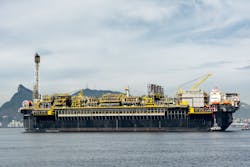Petrobras building production at presalt Brazil field centers
Offshore staff
RIO DE JANEIRO – Petrobras’ 1Q production averaged 2.77 MMboe/d, helped by ramp-up at the FPSO P-70 on the Atapu field in the presalt Santos basin.
However, the figure was 5% lower compared with output in 1Q 2020. This was mainly the result of field divestments last year and in early 2021, and declines at projects that have passed peak production.
The worsening of the COVID-19 pandemic in Brazil forced the company to further reduce personnel numbers on its platforms and to adapt its boarding regime, to limit the risk of contamination and the associated impact on operations.
Petrobras’ 1Q presalt output of 1.90 MMboe/d represented 69% of its total production, with output from the Búzios field platforms up by 14%, mainly the result of improved efficiency and stabilization measures.
There were further production gains at the Tupi field following ramp-up of the P-67, and at the Berbigão, Sururu and Atapu fields with the continued ramp-up of the P-68 and P-70.
Post-salt production was 6.3% down on the previous quarter, due to higher maintenance-related losses at the FPSO Cidade de Niterói serving the Marlim Leste field; the P-52 at the Roncador field; the P-56 at Marlim Sul; and the P-25 and P-31 at Albacora.
Petrobras’ shallow water and onshore production in 1Q was also lower at 109,000 b/d, mainly due to the sale of the Baúna field in the Santos basin to Karoon Energy.
The FPSO Carioca, which arrived in February at the BrasFELS shipyard in Angra dos Reis for the final modules integration stage, is due to start operating in 3Q on the Sépia field.
Recent modifications to flexible subsea pipelines serving Búzios and Tupi allowed for life extensions of the systems in both cases, reducing the risk of production loss caused by CO2-induced stress corrosion.
04/28/2021
